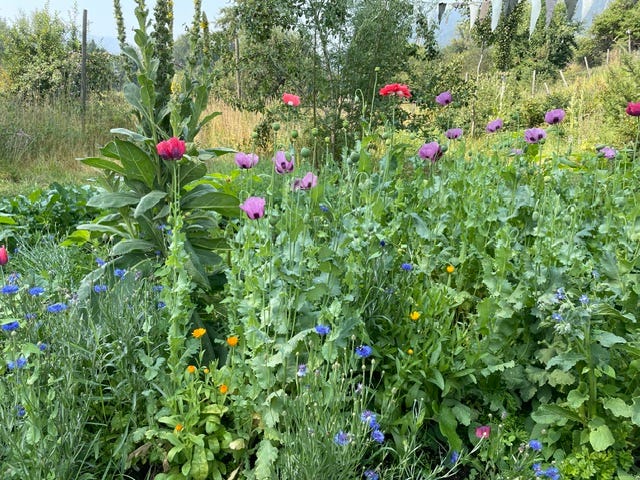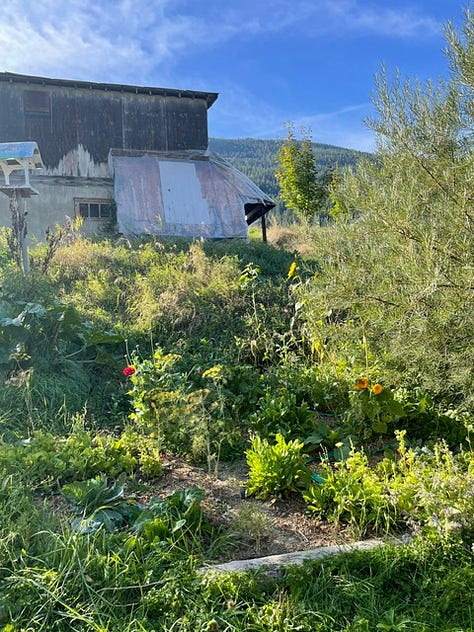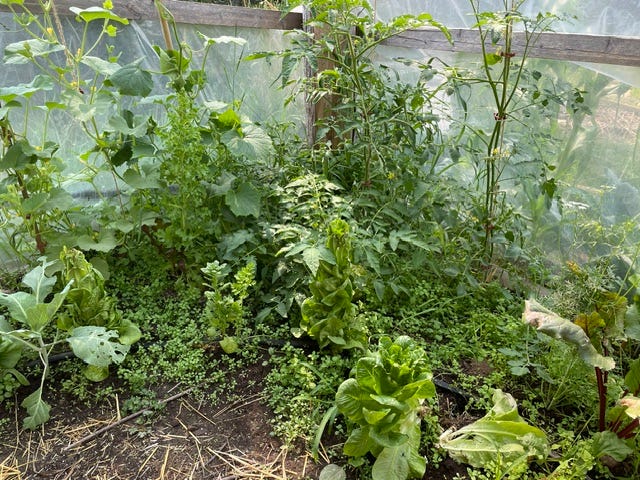
The time has slowly arrived in many overwintering homes. Where the fires still burn and the teas still steep, yet the mind dreams of spring. The quiet flips through seed catalogues while feet stay warm by the stove. The drawing up rough plans for what wants to be planted where. The garden is ever so slightly coming to life again, even if for now it is in the hearts of her tenders. The land begins to stir and grow restless. Longing to shake off this winter sleep, yet feeling its pull being held just a little bit longer. For now, we dream.
Yes, I have begun dreaming of the seeds that long to be planted in this garden. So many seeds! It feels invigorating and inspiring to be a part of all the beautiful heirlooms that one will never find in a grocery store, even better, that can be grown and picked with ones very own hands. Purple carrots and yellow watermelon and white eggplants. The inner child jumps for joy at all that potential for play.
As I have been sinking into the visioning for the year's garden, I'm reflecting on how I desire to show up in that space in this new cycle. What I learned from last year and what longs to be implemented, improved, or discarded. My vision is a wild utopia. A vibrant green jungle with bursts of unexpected yet abundant colour. Vines climbing up sticks and flowers full of bugs. Oh yes, and some veggies here and there. I can’t deny that a big spark of joy for me in the garden is all the wildflowers. Yet this year I want to see how many vegetables I can squeeze into the new garden beds that I prepared in the fall ( yay for me planning ahead for the spring when I would be heavy with baby and have no care for such hard labour ). You won’t catch any neat rows and evenly spaced crops in my ol’ garden. Mama likes to pack it in. To mix and match. One bed can be full of many different veggies and flowers and herbs. Heck, usually some surprise plants that I forgot I planted. Is it chaotic, yes. Perhaps this year I would like to add a tad bit more order into the space. At least know roughly what I plant where instead of guessing what everything is before it fruits or blooms. That was always a fun game, but we are evolving here. I want to find a balance between a diverse wild ecosystem and a high yielding vegetable garden, and a beautiful flower/bug oasis.
I want to prioritize heirloom plants, unusual crops, perennial herbs and trees that may stay and nourish the space with each passing year. Flowers that will reseed for generations. And intermingled in all of that vegetables that will thrive and feed me and my family. We shall see what can be done this year. Honestly, this sort of garden style is an ever-evolving thing. A living thing. A thing that grows more complex, more intricate every year. In every cycle, things are added, removed and altered, naturally through the process of inhabiting such a living space.
My focus is on creating a diverse ecosystem. In such a place, there are many different plants that serve many different roles. Tons of niches that are filled by multitasking crops, and this divine design creates many layers of assortment and complexity in the care of the ecosystem. It's not so clear cut as to say this plant gives this and that plant gives that. As though life can be compartmentalized into clean boxes, taped up and packed away into their respective places. For example, a pea plant can offer shade to other low-growing crops while at the same time attracting pollinators to its flowers, then at the end of its life, it decomposes back into the soil and gives nitrogen for other plants to absorb. It is this simple intricacy that keeps an ecosystem in harmony. There are many plants doing the same thing, while also doing many different things. When you have several plants that fill the same or similar niches, it strengthens the resilience of such a space. There is overlap. There is a deeply interwoven network of co-creaiton.



This diversity also includes plants that may mature and grow into the ecosystem over many generations. Things like perennial herbs, shrubs, and trees are really important parts of having a maturing, diverse garden landscape. This process helps to ‘close the loop’ so to speak, in the energy that is spent or invested in the garden.
In a standard annual vegetable garden, nutrients flow out in a straight line. Crops are planted, perhaps some nutrients are put into the soil through compost and fertilizer, they are watered regularly, the ground is weeded, and at the end of it all, the crops are harvested and the garden is left bare for next year. Everything that was added into the soil through the growing season has already been leached out. The beds left uncovered are once again depleted of whatever nutrients were added, the water drains out and the soil is left compact and parched.
When we say we are closing the loop of nutrients within a garden, we are keeping all the substance that is added into the biome, in the biome. When we don't have as much leaving the ecosystem, the space may continue to get more and more enriched, and fewer resources are wasted. How we can do this is, for starters, what was mentioned above. Covering the soil. During the growing season, this can look like cover crops that grow low to the ground, which is what we see in a lot of healthy meadows and deciduous forests. Cover crops serve several purposes. They create shade and cover for the delicate biome of the soil. They hold more moisture in the soil through their roots and due to the shade they're creating that prevents evaporation. They are a home and habitat for beneficial insects. And, when they are flowering ground cover, they attract pollinators. At the end of the growing season, these cover crops decompose and give their nutrients back to the soil. Thus, replenishing, aerating and holding moisture. Another fun cover crop is strawberries which obviously have the added benefit of their delicious fruit in your garden.
Another way we can cover the soil is by adding mulch, which is what we see in coniferous forests. Mulch can be anything from grass clippings to straw to plants you just pulled out of the garden. This matter will serve in much the same way as what I mentioned, it is just not living matter anymore so this is something that will immediately start to decompose and melt back into the soil.
As I mentioned, adding perennial plants scattered throughout your garden space, even your beds, is very beneficial and another layer of holding nutrients within the garden landscape. As they mature, their roots grow more vigorous, holding, extracting and releasing more nutrients from and into the soil. Their leaves drop and naturally cover the ground below it. They offer shade which also serves to hold more moisture in that micro environment. Plus they have the added benefit of offering whatever fruit or leaves they produce. Fruit trees or berry bushes are a great example of something that deeply serves such an ecosystem for its benefits and its nature as a food crop. The more perennial plants there are around, the more mature spaces there are for pollinators to come back to, for bugs to be housed in, more mature roots to nourish the soil and so on.
When we are looking at where to plant what, we are invited to really pay attention to the land. Where does the water flow, what route does the sun take, how does the wind blow in such a place. This obviously will impact what we plant where and how we can work with the elements to help us here. We want to also invite the animals to assist. The birds, the bugs, the bees, the mice, the snakes. Such critters greatly contribute to a healthy, living and wild garden ecosystem just as they would in an uncultivated wild place. In an immature annual garden or suburban lawns, pests become a problem because the ecosystem is depleted. An annual garden is more susceptible to pests and diseases because it doesn’t have the stability of a mature ecosystem. Its plants are constantly being uprooted. Soil depleted. Niches are not being filled. Where there is prey, in a healthy environment, there will be predators. This can look like birds or wasps that eat bugs that would otherwise run rampant. In an ecological garden, the points I mentioned above like planting perennial crops or even planting more wildflowers, also serve to fill this niche. Balancing the scale of predator to prey. That’s why in such gardens pests aren’t so much a concern as they are in traditional annual gardens. And if they do become an issue, they can be quickly corrected. Pests are kept in check and the sacred cycle of I eat you, you eat me prevails to restore balance and harmony. In such a closed loop system, we are nurturing PARTNERSHIPS. Interconnectedness. An intricate web of relations rather than a straight line of production.
Those are two very simple ways one can implement the idea of closing the loop within their garden and move closer towards a thriving ecosystem. This stuff really isn’t complex. It is just a reframing of how we think of the garden, and how we show up in the space. Once we reorient our attention to this way of existing in this space, the steps become obvious and we are naturally guided by the land into what is needed in the space. From there it can get more complex through creating living guilds within our garden space which is an aspect of permaculture design, or learning about the art of composting. The point is, that this process can really be as simple or as complex as you desire. The key to showing up and holding such a space is moving from the heart as a part of and co-creator of this habitat. Befriending the critters, loving the bugs, smelling the flowers. Moving from the heart.

Happy garden visioning everyone. I would love to hear what topics you would like to hear more about within this topics so leave a comment and let me know!
some other posts on gardening and land communion





I have been moving in this direction for many years, starting from perhaps the complete opposite. My father "perfected" a system of gardening in 4' x 18' plots, twelve of them in a perfect grid, each dug 26" deep, lined with metal, with hardware cloth in the bottom to block moles and gophers. Each one "turned over" annually, each one with a strip around the outside kept hoed and bare lest any weeds find their way inside.
Each year, I find, my rows are less straight, I let more weeds grow, I leave plants from last year in the mix, allow sunflowers to grow where they will. I'll be moving this year, and my next garden will be wilder, I think. Less square. Fewer "chores" to keep things orderly, just a tending to nurture growth. Fewer inputs, more cycles.